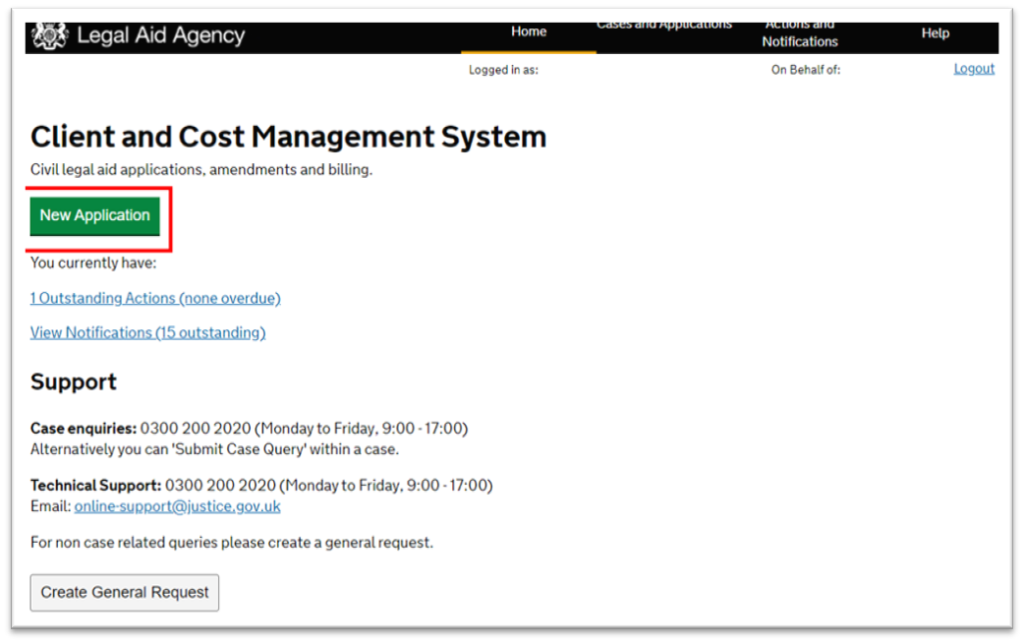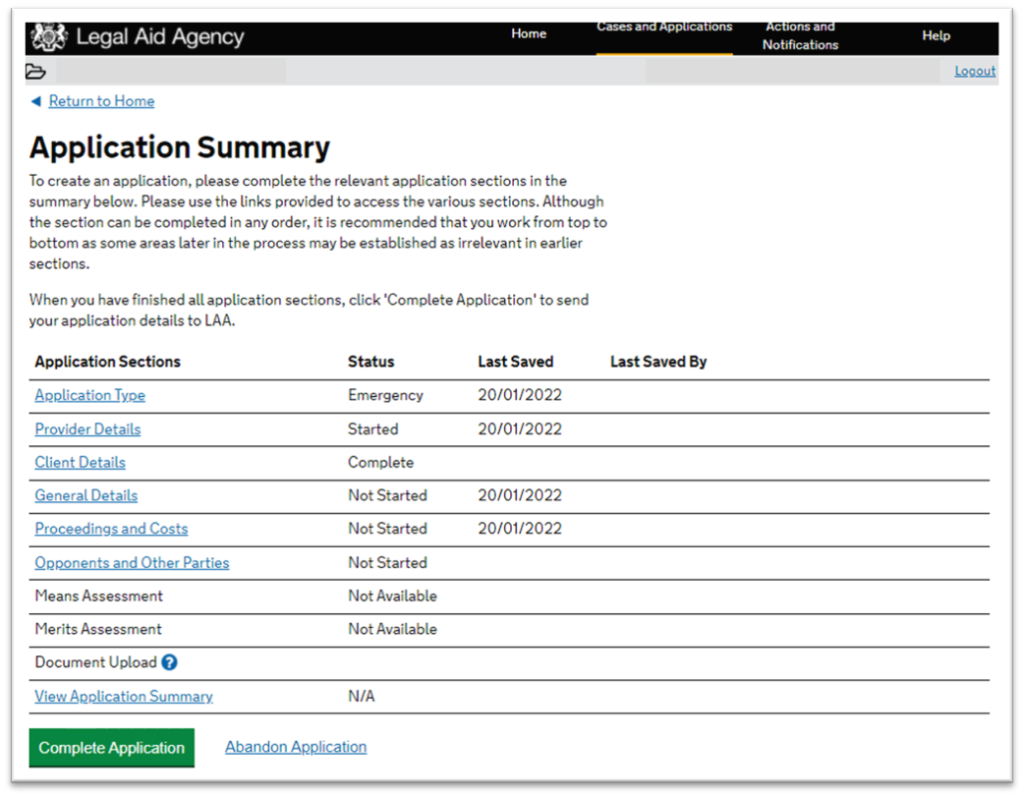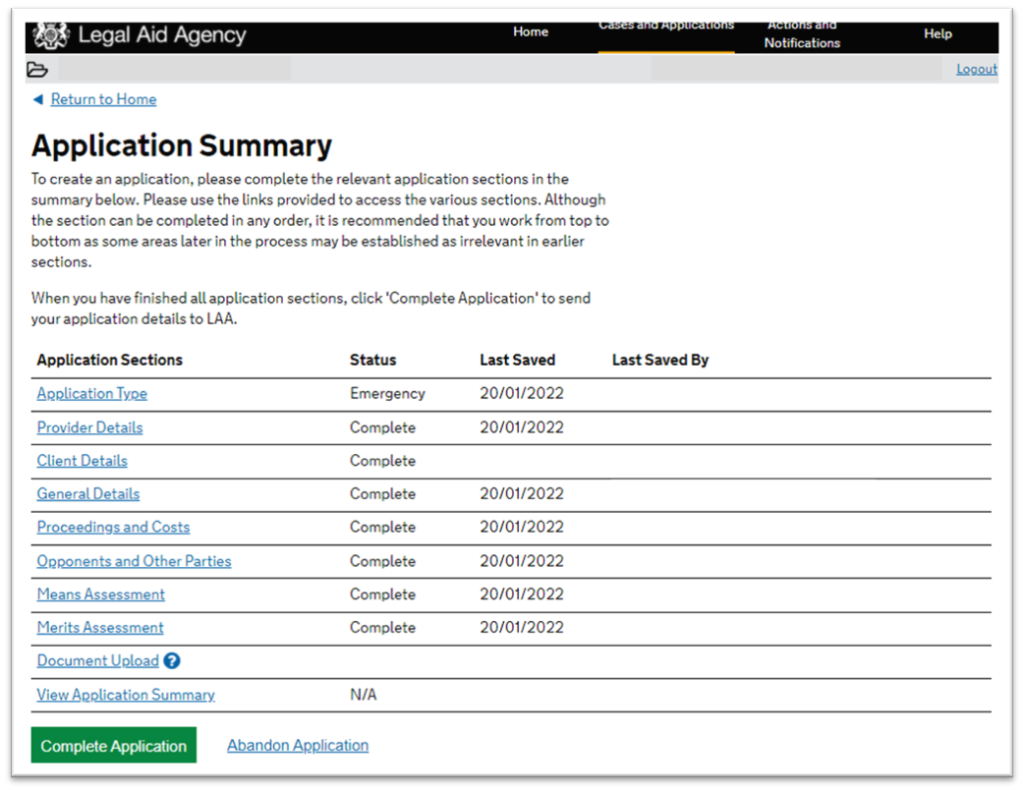Getting setup on CCMS
Granting CCMS access to an existing user
If you already have an LAA Online Account, for example, because you submit criminal applications or use CWA, our Online Support Team can amend your account and provide you with access to CCMS.
Email: online-support@justice.gov.uk
Telephone: 0300 200 2020
You can also use our webchat service.
NOTE: Before contacting the Online Support Team, you will need to have obtained authorisation from your Contract Manager or firm’s director via email.
Registering a user and granting access to CCMS – no CCMS Firm Administrator
If you do not have a CCMS Firm Administrator, for example, because they have left employment, the Online Support Team will be able to assist you with creating a Legal Aid Account. You will also need to have obtained authorisation from your Contract Manager or firm’s director via email.
We will email your login details once an account has been created, at which point you will be able to assign permissions to CCMS.
Starting an application for legal aid
Once your user account has been created, visit the LAA Online Account and select Client and Cost Management System.
From the Home screen select ‘New Application’.

Select your office from the drop-down menu and press ‘Next’.
Select ‘Crime Civil’ as the Category of Law and press ‘Next’.
You will need to decide whether to make an Emergency or Substantive Application for legal aid.
Emergency Representation
Applications for emergency representation must satisfy the interests of justice test. Further information is available at paragraphs 7.28 – 7.30 Lord Chancellor’s Guidance under Section 4 of the Legal Aid, Sentencing and Punishment of Offenders Act 2012.
Emergency civil legal aid certificates are limited to the urgent necessary steps in the proceedings. They cannot be extended beyond an 8-week time limitation.
If you apply for emergency representation and receive an emergency civil legal aid certificate you will need to make a Substantive Amendment for a full certificate. This is a requirement even where the work is concluded within the scope of emergency representation.
Emergency representation cannot be granted under delegated functions in relation to gang-related violence proceedings.
Select ‘No’ to use of Delegated Functions and press ‘Next’.
You will need to complete a Client Search to check if your client is registered within the LAA system. Mandatory fields are your client’s first name, surname at birth and date of birth. You may also include a unique identifier in the search, for example, your client’s National Insurance Number.
Once the fields have been completed press Search.
If the search returns no results you will need to select ‘Register New Client’. You will be presented with a privacy notice on the next screen. Tick the box to confirm your client or their representative has read and agreed to the privacy notice and press ‘Next’.
You will need to enter Basic Client Details. The mandatory fields are Title, Surname, Country of Origin and Marital Status. Select ‘Next’ once entered.
You will need to enter Client Contact Details. The mandatory fields are at least one contact telephone number, password/password reminder, and correspondence method. We will use the password information to verify your client’s identity if they contact us. Select ‘Next’ once details have been entered.
You will need to provide Client Address Details. You may tick the box if your client is of no fixed abode. Once details have been entered select ‘Next’.
You will need to enter Equal Opportunities Monitoring information. This includes an option to provide details of any special requirements your client may have. Select ‘Next’ once details have been entered.
You will be taken to the Summary of Client Information screen. You should review the information provided and edit details if necessary. Select ‘Submit Client’ once the information has been checked.
At the Submission Confirmation screen select ‘Next’ to start completion of the application for legal aid.
Completing the application sections
You will be presented with the Application Summary screen.

The application type and client details have already been completed based on the information supplied. The remaining sections will need to be completed before the application can be submitted.
Select Provider Details to supply the fee earner’s details and the Contact Name for the application. Once the details have been completed select ‘Confirm’.
The Application Summary screen will now be updated to show a Complete status against Provider Details.
Select General Details to complete the next section of the application. You will be asked to confirm the Correspondence Address details for your client. Select ‘Next’ once details have been entered.
You will be taken to the Linked Cases Summary screen. You will be able to link this application to other cases if you represent other parties within the same proceedings. If you do not wish to link the application to other cases, select ‘Confirm’.
The Application Summary screen will now be updated to show a Complete status against General Details.
Select Proceedings and Costs to complete the next section of the application.

Select ‘Add Proceeding’. From the Matter Type drop-down menu select Crime Civil and select ‘Next’.
From the Proceeding drop-down menu select Part 1 Injunction ASBCPA – Crime Civil and select ‘Next’. It will be necessary to select this proceeding because an appropriate gang-related violence wording is not currently present under the ‘Crime Civil’ Matter Type.
Select Defendant/Respondent as the Client Involvement and Full Representation as the Form of Civil Legal Service. Select ‘Next’.
You will need to insert a Scope Limitation. Click ‘Hearing’ to edit the Scope Limitation.

In the Scope Limitation Wording box enter the following text:
‘Limited to all steps up to and including the final hearing in an action relating to an application for an injunction under Part 4 of the Policing and Crime Act 2009.’

Select ‘Confirm’ to return to the Proceeding Details screen. It will not be necessary to add a further Scope Limitation. Select ‘Next’ to confirm the Scope Limitation details.
Select Opponents and Other Parties. Select ‘Add Organisation’ and complete the details to perform a search. If your search returns a match you can select ‘Use this record’ to add the organisation as the opponent. Alternatively, you may select the option Create New Organisation. Once you have selected the opponent you will need to provide details of their relationship to the case and your client from the two drop-down menus. Select ‘Confirm’ once completed.
If you do not need to add any further Opponents and Other Parties, select ‘Return to Create Application’.
Means and Merits Assessments
The Means Assessment and Merits Assessment options are now available for completion.

Next you will need to complete the Merits Assessment. CCMS will ask questions regarding the merits of the case.
If you have created an Emergency Application, select the option that you are making an urgent application. You will be asked to provide brief details of the urgency, and once this is completed, select ‘Next’.
You will be asked why delegated functions have not been used. You cannot grant funding under delegated functions unless you have a Public Law Category Specification under the 2018 Standard Civil Contract. Select ‘Next’ once this field has been completed.
You will be asked to provide Emergency Details. Select the reason for urgency from the list of options and click ‘Next’ once the fields have been completed.
You will be asked whether your client has previously received legal aid and the reasons why your client is applying for representation. Select ‘Next’ once completed.
You will be asked to provide General Details about the case, including the date your client first visited your firm, the main purpose of the application, and the number of clients you are representing in the proceedings. Select ‘Next’ once completed.
You will be asked whether proceedings are currently before the court. If proceedings have been issued answer ‘Yes’ and complete the fields. Select ‘Next’ once complete.
You will be asked if the case has been listed for a final contested hearing. Select ‘Next’ once complete.
You will be asked if the client requires separate representation from other parties in the proceedings. Select ‘Next’ once complete.
You will be asked a series of questions to help CCMS route the application to the appropriate LAA team. This includes:
- likelihood of costs exceeding £25,000
- whether the proceedings relate to the client’s capacity
- whether it’s a multi-party action
- whether the client has full or partial UK status
Select ‘Next’ once complete.
You will be asked to provide details of alternative funding. This includes answering questions about whether other persons might benefit from the proceedings who can reasonably be expected to fund the case. You will also need to answer questions about any insurance policies held by the client. You will be prompted to provide specific answers to questions about After the Event Insurance (AFE) and Conditional Fee Arrangements CFA). You should complete both boxes explaining the proceedings are unsuitable for AFE and CFA. Select ‘Next’ once complete.
You will be asked questions about any attempts which have been made to settle the matter. You will be prompted to provide specific answers if attempts to settle have not been made, which should be answered with an explanation that your client is the respondent in proceedings. Select ‘Next’ once complete.
You will be asked to provide information about your client’s likely prospects of success. Select ‘Next’ once complete.
Prospects of success means the likelihood that your client will obtain a successful outcome at trial or other final hearing.
Successful outcome means the outcome a reasonable individual would intend to achieve in the proceedings in all the circumstances of the case.
For further information on assessing prospects of success refer to Regulations 4 and 5 of the Civil Legal Aid (Merits Criteria) Regulations 2013 and paragraph 4.1 Lord Chancellor’s Guidance Under Section 4 of LASPO 2012.
You will be asked to provide details of your estimated costs to trial (excluding VAT). Select ‘Next’ once all questions have been answered.
You will be asked to confirm why this matter is considered proportionate for the purposes of the regulations. Select ‘Next’ once details have been provided.
You will need to assess whether the case is of overwhelming importance to your client, for example, if the case concerns life, liberty, or physical safety. You will also need to confirm if you are contending that the case has human right elements. If so, you will to provide details of the articles your client will rely upon. Select ‘Next’ once complete.
You will need to provide your client’s statement of case. You can either complete the statement of case fields or upload an attachment on the next screen.
Applications for civil legal aid must satisfy the requirements set out in the Civil Legal Aid (Merits Criteria) Regulations 2013. In particular, if applying for full representation, you will need to satisfy Regulations 39, 41, 42 and 43.
If you are applying for investigative representation, Regulation 40 will need to be satisfied. The application for civil legal aid is merits tested, and your statement of case must provide sufficient information to demonstrate those requirements are met.
Regard should be given to Regulation 7, which defines the cost-benefit test applied at Regulation 42.
Applications for civil legal aid in gang-related violence injunction proceedings will need to satisfy the ‘reasonable private paying individual’ test. You will need to show that the potential benefit to be gained from the provision of civil legal services justifies the likely costs, such that a reasonable private paying individual would be prepared to continue the proceedings having regard to the prospects of success and all the other circumstances of the case.
The statement of case will need to provide details of what your client is trying to achieve and a reasoned argument as to the prospects of achieving that aim. This should include details of your client’s response to the allegations.
Once you have provided your client’s statement of case you will be asked whether you would like to provide additional supporting documents. We will require a full copy of the pleadings, which should include any witness statements. You should upload your client’s statement in response to the allegations if one has been filed.
You will be asked to provide confirmation that your client will sign the relevant declaration prior to submission of the application. There is space to provide an explanation if the declaration will not be obtained before submission. You will also be asked to confirm that you have explained the implications of the certificate being revoked to your client.
NOTE: Revocation may occur if your client fails to comply with requests for information on the assessment of this financial eligibility. If funding is revoked, they will become liable for any costs incurred under the emergency civil legal aid certificate.
You will be taken to the Merits Declaration page. Tick the box to confirm the client, or their representative, has read and understood the declaration. Select Complete on the next screen.
You will be presented with an Assessment Summary. Check the details provided are accurate and select Confirm.
Once the Means and Merits Assessments have been completed you can select the option ‘Document Upload’.
CCMS will display details of the documents you need to provide based on the information supplied in the Means and Merits Assessments. You will see Yes/No options for each item, allowing you to indicate whether you wish to upload the documents with the submission of your application. Once ‘Yes’ is selected you will be presented with the ability to select files from your computer. You will need to indicate which document is being uploaded from the Document Type drop-down list. There is also an option to provide a Document Description.
You do not have to upload documents at this point. If the application is submitted without documents, we will send you a notification to supply them separately.
NOTE: We will be unable to consider your application for legal aid until the documents have been provided.

Except for the Application Type, each of the Application Sections should now show a Complete status.

Select Complete Application, which will take you to the Application Summary Screen. Review the details provided and select Back at the bottom of the screen if you identify any entries which need amending. If the details provided are correct you should select the Print option to access a copy of the Application Summary. Your client will be required to sign the printed version of the summary, which should be retained on file for auditing purposes.

Select ‘Next’ once you have printed a copy of the Application Summary. You will need to tick the box to confirm you have obtained the necessary signed declaration from your client for retention on the client’s file. Select Continue to complete the submission of your client’s application for funding.
Managing live cases
The Legal Aid Agency (LAA) will issue a funding certificate if the relevant merits and financial eligibility criteria are satisfied. Funding certificates are effective from the date of issue, although there are provisions to request the backdating of a determination.
The funding certificate will specify the proceeding for which funding can be provided to your client. It will also contain scope and costs limitations, which differs from funding issued in criminal proceedings.
The scope limitation specifies the point in the proceedings within which you are authorised to represent your client. Once that limitation has been reached you must seek an extension to the scope of the certificate to continue providing representation.
Costs limitations work similarly. The default costs limitation is £2,250 excluding VAT. This covers profit costs, disbursements and counsel fees. You will need to apply for an amendment to increase the cost limitation. Amendment requests to increase costs limitations should include details of the costs incurred to date and an explanation of how future additional costs have been calculated.